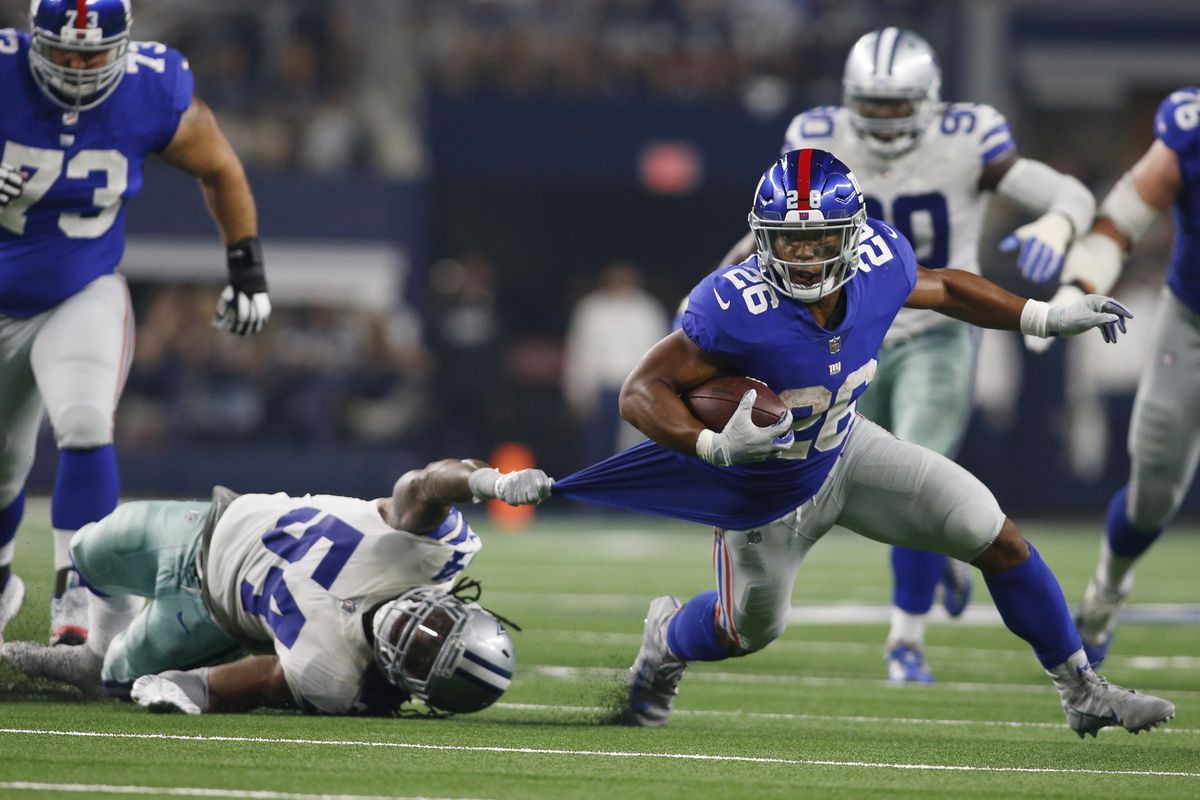- We’ll examine the effect that a team’s implied win probability (i.e. Money Line odds) have on individual NFL player props — do projected game scripts affect prop results as much as we think?
- This data comes courtesy of the player prop database at playerprops.football and is composed of all closing lines from Bovada going back to 2017
- This is the first of a four-part series, as we look at this effect on props across all positions, starting with RBs
- Our NFL Early Bird props Packages are available for a limited time — Save 20% on a full season with 100% refund guarantee if the season is canceled at any point
The Cowboys are 23-5 when Ezekiel Elliott rushes for at least 100 yards. That’s a stat old-school football analysts like to harp on as evidence supporting a run-heavy approach. In actuality, the causation arrow goes in the other direction — it’s easier for Elliott to rack up yards when the Cowboys are winning and trying to drain the clock.
As such, you’d expect running backs to get more rushing attempts and yardage when their team is favored, leading to more overs in rushing totals in those games. On the flip side, you’d expect quarterbacks to attempt more passes when they are underdogs.
Here’s the problem with that line of thinking: Linemakers and the general betting public know that too. And from what we’re about to see, it appears they’re adjusting for it more than you might think.
Let’s take a look.
Editor’s note: Keep in mind that while this data is a helpful guide, it is not perfect nor complete — it’s one snapshot in time from one specific betting market and results will vary across different books.
Game Script Matters for NFL Props, and Books Know It Too
How do RBs perform relative to their Over/Under total on different prop bet types when their team is favored?
Because it doesn’t seem fair to put all favored teams in the same bucket, I separated them into three groups:
- Heavy Favorites (>=75.0% implied win probability or at least -300 on the Money Line)
- Sizable Favorites (62.5%-74.9% implied win probability or between -167 and -299 on the Money Line)
- Slight Favorites (50.0-62.4% implied win probability or +100 to -166 on the Money Line)
You can also use this reference table below to see the definition of each group.

Let’s start with a look at how RBs playing for the favorite fare.

Next, we’ve got the same table for RBs whose team was the underdog.

How to Read the Table
Let’s take rushing yards as an example. Most of us would expect that an RB whose team is a heavy favorite would go over his rushing line more often than an RB whose team is expected to get blown out, given that we can expect them to get more attempts when they are leading.
In fact, the effect appears to be negligible. RBs on heavy favorites go over their total 43.4% of the time, and those on heavy underdogs going actually go over their betting totals slightly more often at 44.6%.
Takeaways
- For the most part, it looks like we want to do the opposite of what you’d assume when it comes to game script. That means it’s still going to be more profitable to keep betting unders on RB rushing yards, even when their team is a heavy favorite.
- Betting the under on receiving yards is extremely profitable regardless of the projected game script — last year, Cort Smith found that RB Receiving Yards and Rush+Rec Yards props both go under the betting line more than 60% of the time.
- It’s also notable how frequently RBs go under their receiving yards and receptions totals as heavy underdogs. We tend to assume those pass-catching backs will rack up plenty of easy receptions when their team is getting blown out, but these are two of the worst bets you can make, potentially because their teams are so bad that they just can’t get anything going on offense.
- Sometimes it’s important to zoom out instead of focusing on just one number. For example, RBs go under their rushing and receiving yards total 67.7% as slight favorites but only 52.8% of the time as slight underdogs. Considering those two buckets are right next to each other, it’s likely the massive difference between the two is at least partially noise.
- For the most part, bucket sizes were pretty robust, but the “Heavy Dogs” category had a smaller sample size (ranging from 55 for rushing and receiving yards to 139 for rushing yards) simply because not many teams were +300 or worse.
- On a related note, there were fewer rushing and receiving props, so the sample sizes were also smaller for that bet type. Most of the buckets for that one had about 140 bets.
How to Play It
As usual, you should continue playing unders, but it’s important to understand that projecting game script probably isn’t giving you the edge you think it is. I would suggest that the reason for that is both linemakers and the betting public are well-aware of those angles and pressing them hard.
So much prop analysis is centered around game script, and yes, Bet the Prop can be guilty of it too. But understanding that you’re not getting the edge you think you are can help you to become a more profitable bettor.
Over the next week or so, we’ll look at this same topic for wide receivers, tight ends, and quarterbacks. Stay tuned!



